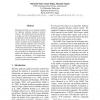Free Online Productivity Tools
i2Speak
i2Symbol
i2OCR
iTex2Img
iWeb2Print
iWeb2Shot
i2Type
iPdf2Split
iPdf2Merge
i2Bopomofo
i2Arabic
i2Style
i2Image
i2PDF
iLatex2Rtf
Sci2ools
EMNLP
2008
2008
A Japanese Predicate Argument Structure Analysis using Decision Lists
This paper describes a new automatic method for Japanese predicate argument structure analysis. The method learns relevant features to assign case roles to the argument of the target predicate using the features of the words located closest to the target predicate under various constraints such as dependency types, words, semantic categories, parts of speech, functional words and predicate voices. We constructed decision lists in which these features were sorted by their learned weights. Using our method, we integrated the tasks of semantic role labeling and zero-pronoun identification, and achieved a 17% improvement compared with a baseline method in a sentence level performance analysis.
EMNLP 2008 | Japanese Predicate Argument | Natural Language Processing | Semantic Role Labeling | Target Predicate |
| Added | 29 Oct 2010 |
| Updated | 29 Oct 2010 |
| Type | Conference |
| Year | 2008 |
| Where | EMNLP |
| Authors | Hirotoshi Taira, Sanae Fujita, Masaaki Nagata |
Comments (0)

